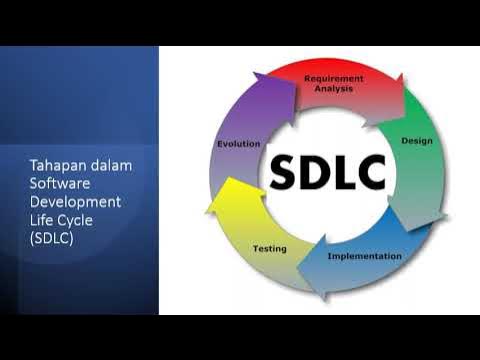RPL - 02 Proses Rekayasa Perangkat Lunak (Software Process)
Summary
TLDRThis video lecture on software engineering focuses on software development processes. It discusses the Software Development Framework, outlining key activities like communication, planning, modeling, construction, and deployment. The lecture then delves into different process models, including the linear Waterfall model, iterative Prototyping, evolutionary Spiral model, and the Unified Process model. Each model's strengths and weaknesses are compared, emphasizing the importance of selecting the most suitable model for a project's specific needs.
Takeaways
- 😀 The video discusses the Software development process, focusing on Software development Frameworks, process flows, and prescriptive process models.
- 📚 A Framework is a high-level perspective of software development, outlining the general processes involved in developing software.
- 🔍 The video explains that Framework activities are the smallest units within the software development process, grouped under umbrella activities for overall management.
- 🗣️ Communication is the first step in the software development process, aiming to align stakeholders on requirements and expected features.
- 📈 The video outlines four main processes within the software development Framework: communication, planning, modelling, construction, and deployment.
- 🔁 Process flows in software development can be linear, iterative, evolutionary, or parallel, each with its own characteristics and applications.
- 🌟 The Waterfall model is introduced as a linear and sequential approach to software development, but it has limitations, such as difficulty in handling requirement changes.
- 🎯 The Prototyping model is highlighted as an approach to quickly develop a preliminary version of the software to gather user feedback and clarify requirements.
- 🌀 The Spiral model is presented as an iterative and evolutionary approach, involving risk analysis and customer feedback at each iteration.
- 🔄 The Unified Process model emphasizes the importance of continuous customer communication and uses a series of five phases: Inception, Elaboration, Construction, Transition, and Production.
- 📊 The video concludes with a comparison of the discussed models, highlighting their strengths and weaknesses, and suggests choosing the model that best fits the project's needs.
Q & A
What is the main focus of the video material discussed in the script?
-The main focus of the video material is on Software Engineering processes, specifically discussing Software development Frameworks, the process flow of software, and prescriptive process models.
What is a Software development Framework as described in the script?
-A Software development Framework is described as a high-level perspective of software development, providing a general overview of the processes involved in developing software. It is structured with Umbrella activities and Framework activities, which are the smallest units of work.
What are the four general processes within the Software Engineering Framework mentioned in the script?
-The four general processes within the Software Engineering Framework are communication, planning, modelling, and construction, and deployment.
What is the purpose of Umbrella activities in the context of Software development Framework?
-Umbrella activities are meant to manage progress, quality, change, and risk within the overall software development process. They ensure that the software development process itself is of high quality, not just the final software product.
What are the different types of process flows for software development discussed in the script?
-The script discusses four types of process flows for software development: linear, iterative, evolutionary, and parallel process flows.
How does the Waterfall model differ from other process models in terms of its process flow?
-The Waterfall model is characterized by a systematic, sequential, and linear process flow where each phase is completed one time and only once, with no iteration, and each process must be completed before the next can begin.
What are the advantages and disadvantages of the Waterfall model as mentioned in the script?
-The Waterfall model's advantages include being easy to understand and plan, effective for small projects with clear requirements, and having straightforward analysis and testing processes. Its disadvantages include difficulty in handling requirement changes, late testing, and obtaining user approval only at the end of the project.
What is the main concept behind the Prototyping process model?
-The Prototyping process model involves quickly developing a prototype of the software to gather user feedback on whether the requirements are met. It helps to clarify user needs and reduce the risk of project rejection.
How does the Spiral model differ from the Waterfall model in terms of its approach to software development?
-The Spiral model differs from the Waterfall model by involving iterative development with customer feedback and risk analysis at each iteration, allowing for a more flexible and controlled development process, especially for large and complex systems.
What is the Unified Process model and what are its unique phases?
-The Unified Process model is an iterative and use-case driven approach that emphasizes the importance of communication with users and simplified methods to explain the system from the user's perspective. Its unique phases include Inception, Elaboration, Construction, Transition, and Production.
How does the script suggest choosing the right software development model for a project?
-The script suggests that there is no one-size-fits-all model and that the choice should be based on the specific conditions and requirements of the software project at hand.
Outlines

هذا القسم متوفر فقط للمشتركين. يرجى الترقية للوصول إلى هذه الميزة.
قم بالترقية الآنMindmap

هذا القسم متوفر فقط للمشتركين. يرجى الترقية للوصول إلى هذه الميزة.
قم بالترقية الآنKeywords

هذا القسم متوفر فقط للمشتركين. يرجى الترقية للوصول إلى هذه الميزة.
قم بالترقية الآنHighlights

هذا القسم متوفر فقط للمشتركين. يرجى الترقية للوصول إلى هذه الميزة.
قم بالترقية الآنTranscripts

هذا القسم متوفر فقط للمشتركين. يرجى الترقية للوصول إلى هذه الميزة.
قم بالترقية الآنتصفح المزيد من مقاطع الفيديو ذات الصلة

Engenharia de Software - Aula 01 - Modelos de processo de software e atividades de software

pertemuan 2 Rekayasa Perangkat Lunak

Engenharia de Software - Aula 16 - Gerenciamento de configurações (Parte 1)

Pengantar Rekayasa Perangkat Lunak (Software Engineering)

Rekayasa Perangkat Lunak : Perangkat Lunak

1.7 Software Process customization and improvement | CS403 |
5.0 / 5 (0 votes)
